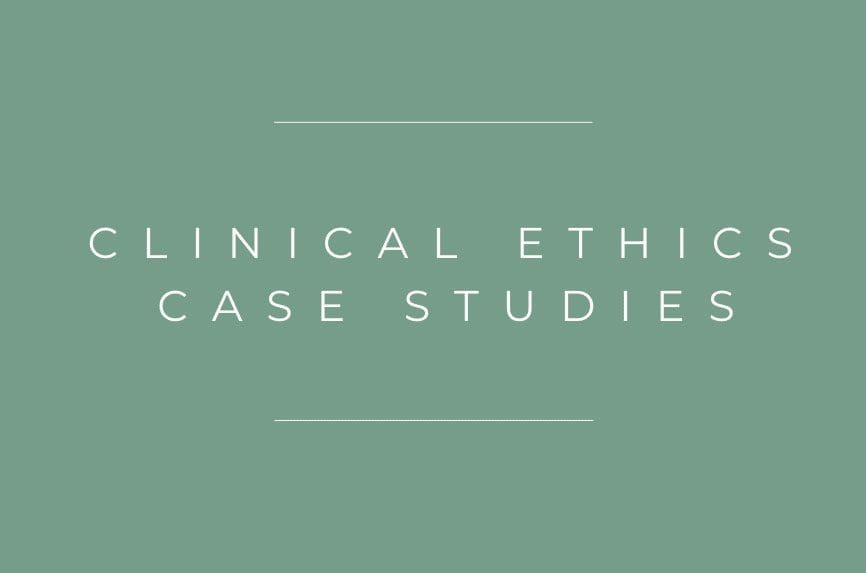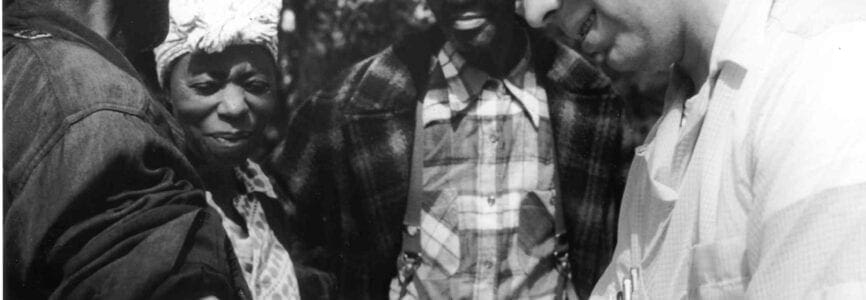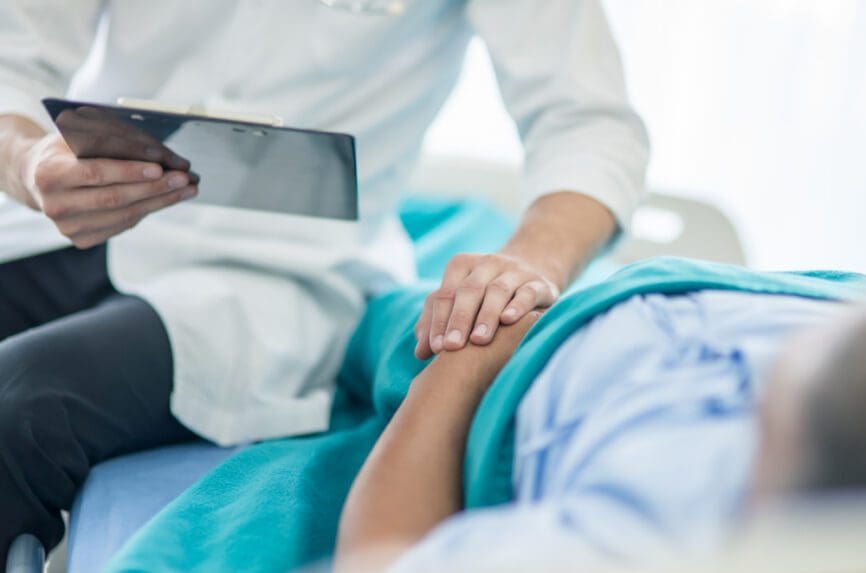Bioethics Forum Essay
Case Narrative
Ms. J, a 45-year-old mother of three, was admitted to the emergency department with significant shortness of breath. With her children by her side, she relayed that she had tested positive for Covid 10 days prior and had not been vaccinated. Having done her own research, she had been self-medicating at home with vitamins. At the hospital she was found to have Covid pneumonia and very low blood oxygen, and was started on a high-flow nasal cannula delivering oxygen at the maximum rate of 60 liters per minute. Her blood oxygen remained low, however, and she was transferred to the intensive care unit to be put on a ventilator. The team reported that, with ventilator support, Ms. J would have a 50% chance of making a full recovery, and that without it she would almost certainly die. That notwithstanding, Ms. J declined to consent to the ventilator.
She explained that, from the various articles she had read, ventilators did not work for Covid, and said she had heard that hospitals were only putting Covid patients on ventilators in order to receive significant remuneration from the federal government. She wanted to leave the hospital immediately to get vitamins that she thought would relieve her shortness of breath. Both the attending physician and the nursing staff were distressed. They reported that, if Ms. J were to remove the nasal cannula and leave the hospital, she would very likely die before making it to the parking lot. But Ms. J was unwavering – she did not believe she was at risk of death by leaving the hospital and she was minutes away from walking out. The team called an ethics consult to help them think through the dilemma between respecting Ms. J’s preference and protecting her from grave harm in the context of false beliefs.
Ethical Analysis and Process
Under normal circumstances, the ethics team would have met with the treating team, the patient, and perhaps the patient’s family with the aim of facilitating consensus among the parties. But there wasn’t time to arrange meetings. Ms. J’s situation was emergent, and the treating team felt that the need for ventilator support was imminent. So, the ethics team spoke to the treating team by phone.
The focus of the phone call was on Ms. J’s capacity to decline treatment. It was acknowledged that patients have the right to refuse any and all treatments, even life-sustaining treatments. However, before honoring a patient’s decision to decline important medical treatment, health care providers have an obligation to assess the patient’s decision-making capacity. While denying someone with decisional capacity the right to guide their own health care is clearly unethical, failing to protect someone without decisional capacity from a harmful choice is a moral failing, as well. The ethics team outlined that patients with decision-making capacity are able to: (1) communicate a clear choice, (2) demonstrate understanding of their medical condition, (3) appreciate their clinical situation and the benefits and burdens of treatment (as well as of forgoing treatment), and (4) reason through the decision, applying the relevant medical information to their values and interests. Importantly, the ethics team also explained that when the decision is particularly consequential (e.g., there is a high risk of avoidable death without treatment), the threshold for a patient being judged as having demonstrated capacity is commensurately high.
The medical team explained that Ms. J was certainly able to communicate a clear choice. She also seemed to understand what the treating team was telling her, and she was able to demonstrate some reasoning as to why she wanted to leave the hospital and why she was refusing to be put on a ventilator. Rather than focusing on her understanding or her reasoning, the ethics team called attention to whether Ms. J was demonstrating sufficient appreciation of her clinical condition and the likely consequences of declining treatment. Ms. J was not merely in disbelief about the likelihood of death should she forgo ventilation; she was in disbelief about the possibility of such an adverse outcome. In short, her false beliefs about her disease meant she was unable to demonstrate sufficient appreciation of the likely consequences of forgoing treatment. The clinical ethicists reminded the treating team that each of the four abilities is necessary for capable decision-making. If there was significant doubt about Ms. J’s capacity, the ethicists said, the treating team should err on the side of caution: judge her to lack capacity and encourage her to identify a surrogate decision-maker (e.g., one of her adult children) to help with treatment decisions.
The Decision
The treating team informed Ms. J of their concerns about her decision-making capacity given the dire consequences of forgoing ventilation, and they asked if they could turn to one of her children to help with the decision. Fortunately, Ms. J identified one of her adult daughters as her surrogate. Her daughter provided consent and was even able to persuade Ms. J that her life depended upon remaining in the hospital and receiving ventilator support. Even more fortunately, the treatment was successful. Ms. J left the ICU a week later and was discharged from the hospital soon after.
Lingering Questions
Despite the auspicious outcome of this case, it raises three challenges. First, shouldn’t the medical team have respected Ms. J’s autonomy and let her make her own decision, even if, in the team’s professional judgement, her decision was a bad one? Again, if Ms. J had demonstrated sufficient decision-making capacity—based on the four abilities outlined above—then, yes. Patients demonstrating capacity get to make their own treatment decisions, even decisions that go against medical judgement and are life-threatening. But when patients fail to appreciate the likely outcomes of their decisions and instead have false beliefs about the consequences of forgoing treatment, they lack decision-making capacity. Respecting the preference of a patient without sufficient capacity does not necessarily respect their autonomy, but instead could potentially constitute a failure to act in their best interest.
Second, it was fortunate that Ms. J’s daughter was able to persuade her mother to accept treatment. But what if she hadn’t been able to do so? When a patient who declines treatment lacks capacity, it doesn’t necessarily follow that treatment should be provided over the patient’s objection. The potential benefits of a treatment must always be weighed against the burdens of the treatment. And, when treatment is provided over a patient’s objection, the benefit should be especially strong, given the significant psychological and emotional harms often associated with involuntary treatment. If Ms. J had not been persuaded, the treating team and her daughter would have had to decide whether treatment, all things considered, was in Ms. J’s overall best interest.
Lastly, what should the team have done if Ms. J’s daughter had the same mistaken beliefs and incredulity about her mother’s dire prognosis? What if her entire family shared those beliefs? What about when those beliefs are widespread? Given the extent of misinformation about Covid treatment, it’s not unreasonable to assume that a significant minority of the U.S. population held beliefs similar to Ms. J’s and that these beliefs may have had a political etiology. Does this mean that a significant minority of the population would lack decision-making capacity if they found themselves in Ms. J’s situation?
There is no well-worked out theory of incredulity and its relationship to capacity. And there are certainly differences between false beliefs, conspiracy theories, and delusions. That notwithstanding, it is important to note that not all false beliefs undermine capable decision-making. Believing that the Earth is flat, for example, does not undermine a patient’s capacity to decide between life-saving treatment and leaving the hospital against medical advice. But when a patient has false beliefs that are pertinent to the decision at hand–for instance, a belief that their illness is not severe and can be remedied with vitamins–these false beliefs can undermine their capacity to make decisions in line with their own conception of the good, about what makes a life worthwhile. Just as incredulity about a diagnosis can prevent patients from making capable decisions about treatment, incredulity about the likely consequences of a decision can lead to a judgement of incapacity.
Daniel Edward Callies, PhD is a clinical ethicist and the ethics program manager for the University of California, San Diego Health System.
Series Editors’ Comment: Considering Humility and Trustworthiness
Honoring patient autonomy cannot be done in a vacuum. Autonomy is relational insofar as it depends on the sharing of information and the ability to work through complicated decisions with others. But the choices we make are molded by social norms, beliefs, and values. This is why the process of eliciting a patient’s values and expertise, sharing relevant clinical knowledge, and, ultimately, supporting the patient in choosing the best pathway forward for them cannot be abstracted from ordinary, deep-seated norms, beliefs, and, importantly, imbalances of power. While health care professionals are trained experts in clinical care, their power to adjudicate truth and falsity of individual beliefs is necessarily limited.
Ms. J’s case demonstrates the importance of balancing respect for autonomy and harm prevention, but also the important virtues of humility and trustworthiness. As many patients know, health care is an imperfect science and health care providers sometimes get it wrong. This complicates their efforts to assess a patient’s capacity based on appreciation of consequences and reasoning about options, especially when assessment of decision-making capacity can be weaponized to justify acting over a patient’s stated objections.
While Callies rightly relies on the gravity of the harm (likely death) and the patient’s lack of appreciation that she might die, health care professionals should question what appreciation means in the context of opposing sociopolitical values and related beliefs. There are broader harms—experienced and witnessed during the Covid pandemic—that result from behaviors that create and perpetuate distrust. Acting over a patient’s objections—even if justified by nonmaleficence for a patient without decision-making capacity—has consequences that can reverberate in families and communities. How should these moral harms be weighed? This is a powerful question that cannot be answered by health care professionals alone.
Ethics consultants can help health care professionals appreciate the importance of this question and work with all engaged parties to determine who has the authority to answer it definitively in a given case. Yet, the question will always recur, as will other moral questions essential to the practice of medicine, each time providing another opportunity to situate the meaning of health care within the context of its practice.
Trust and distrust arise in case-by-case enactments of power and authority in everyday health care practice. The authority that trained health care professionals have over shaping clinical conversations carries a risk of harm: in attempting to focus on medical facts, health care professionals may circumvent open speech and, in the process, sow distrust and convey bias.
This is the heart of the moral dilemma posed by the case of Ms. J. It is right to question whether honoring choices tied to reasons that are personal, even political–and are disputed by many health care experts–could serve to build patient or community trust and support broader community benefit, even if honoring those choices means risking a patient’s life. At the same time, the death of such a patient risks increasing distrust in the capacity of health care professionals to save the lives of patients who are vulnerable to the harms of the politicization of medical facts.
Ultimately, ethics consultants can support serious consideration of patients’ voices and rights, while simultaneously building trust and minimizing harm, by helping health care professionals align medical care with the values conveyed by their patients. After assessing a patient’s capacity to make decisions, with close attention to possible biases at play and holistic consideration of the severity of the risks to the patient, ethics consultants may sometimes conclude that life-saving therapy cannot be provided over a patient’s objection. These decisions should always be recognized as uncertain and made with humility.
– Georgina Campelia and Thomas Cunningham
Learn more about the series, Clinical Ethics Case Studies for Hastings Bioethics Forum.
Read the previous essays in the series here, here, and here.
Attention clinical ethicists: learn how to contribute to the series.












